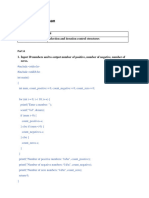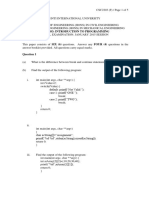0% found this document useful (0 votes)
19 views12 pagesModule 3 QB
The document provides explanations and examples of various programming concepts in C, including loops (for, while, do-while), jump statements (break, continue, goto), conditional statements (if-else, nested if-else, switch-case), and functions to perform specific tasks like checking Armstrong numbers, calculating LCM, and classifying BMI. It also includes flowcharts for decision-making processes and examples of programs for specific functionalities. Overall, it serves as a guide for understanding control flow and decision-making in C programming.
Uploaded by
kashishgupta9892Copyright
© © All Rights Reserved
We take content rights seriously. If you suspect this is your content, claim it here.
Available Formats
Download as PDF, TXT or read online on Scribd
0% found this document useful (0 votes)
19 views12 pagesModule 3 QB
The document provides explanations and examples of various programming concepts in C, including loops (for, while, do-while), jump statements (break, continue, goto), conditional statements (if-else, nested if-else, switch-case), and functions to perform specific tasks like checking Armstrong numbers, calculating LCM, and classifying BMI. It also includes flowcharts for decision-making processes and examples of programs for specific functionalities. Overall, it serves as a guide for understanding control flow and decision-making in C programming.
Uploaded by
kashishgupta9892Copyright
© © All Rights Reserved
We take content rights seriously. If you suspect this is your content, claim it here.
Available Formats
Download as PDF, TXT or read online on Scribd
/ 12
























































































